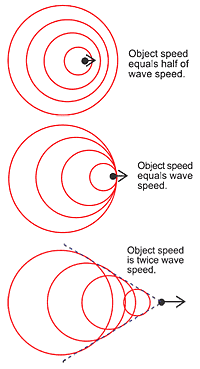Breaking The Sound Barrier - The Physics
Have you ever experienced the ‘sonic boom’ caused by an airplane flying overhead faster than the speed of sound? Those living in the UK may remember the characteristic boom of the supersonic passenger jet Concorde during its short-lived program. What causes this window-shattering phenomenon?
When an airplane travels close to the speed of sound, propagating waves ‘pile up’ in front of it. This idea was discussed in my article on the Doppler effect (https://steemit.com/science/@cjrc97/the-doppler-effect-how-does-it-work) and reading that first will make understanding this article a bit easier!
Modelling sound waves as pressure fluctuations
Sound waves are longitudinal (rather than electromagnetic waves, which are transverse much like waves on a string) which means that they can be described as pressure fluctuations (peaks and troughs in the pressure of the air through which the wave is propagating). As an airplane approaches the speed of sound, the ‘pile up’ of wavefronts ahead of it constitutes compression of the air. When the plane surpasses the sound barrier (the force exerted by the compressed air upon the plane’s nose) it is travelling faster than the speed of sound. At this point, it is moving faster than its emitted sound waves propagate, and waves overlap in the plane’s wake. There is a constructive interference (adding up) of compressional wavefronts along the dotted lines in the diagram below, where pressure is greatest. This results in a 3D cone shaped region of very high pressure behind the plane. This representation of a pileup of wavefronts is similar to that used to explain the Doppler effect:

Pressure difference as a shock wave
Remember, sound is a wave described as pressure peaks and troughs, and for every compression (point of greatest pressure) there is a rarefaction (point of lowest pressure) where the pressure fluctuations interfere destructively. Thus the cone of extreme pressure is surrounded by areas of very low pressure, and this large localised pressure difference is experienced as a strong shock wave when it reaches the ground.

The greater the size and mass of the body compressing the air, the larger the pressure difference between interference maxima (peaks and troughs) and the stronger the shock wave. This is why a Lockheed Martin F-35 Lightning II produces a shock wave that might rattle your windows, but a cracked whip, which produces a small sonic boom when its tip breaks the sound barrier, will not. The plane will create a constant conical shock wave in its wake as long as it continues to travel faster than the speed of light – a cracked whip tip, however, travels at supersonic speeds for only a fraction of a second, and so produces a momentary shock wave.
You may have noticed that you only experience a sonic boom once a supersonic airplane has passed you - our conical pressure fluctuation approach to the problem explains why this is. After all, the plane is, in essence, outrunning its shock wave!
References:
http://www.physicscentral.com
https://media.giphy.com/media/
hey man great post
Id like to nominate it in a curation group im in
This gem of a post was discovered by the OCD Team!
Reply to this comment if you accept, and are willing to let us share your gem of a post! By accepting this, you have a chance to receive extra rewards and one of your photos in this article may be used in our compilation post!
You can follow @ocd – learn more about the project and see other Gems! We strive for transparency.
Thanks for the feedback - I would be honoured!
Great, I'm glad you enjoyed the article.